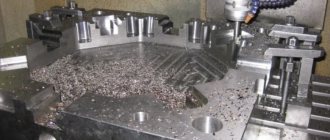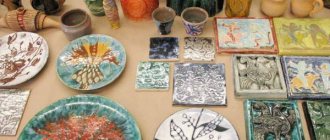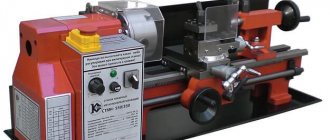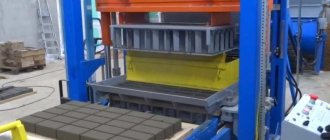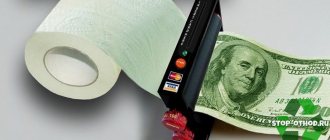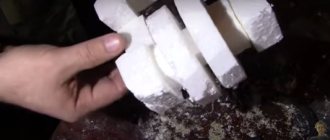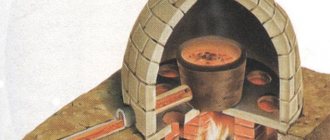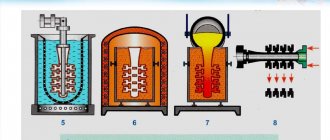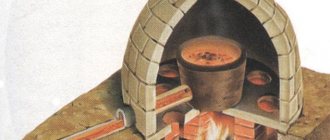Beton-House.com
Website about concrete: construction, characteristics, design. We combine the experience of professionals and private craftsmen in one place
Concrete casting technology is suitable for making small figurines as well as massive objects such as flower bowls, shells, etc.
Concrete is a building material known to mankind for a very long time. So long ago that today there are heated debates about the natural origin of the building material of the Egyptian pyramids, since recent studies show the presence inside the “megaliths” of traces of sheep wool and other foreign inclusions, which by definition cannot be in real stone.
Unfortunately, this has nothing to do with the topic of our article, although it is very interesting - our goal is to find out how the production of molds for casting concrete takes place, as well as the process of pouring concrete objects.
Cast concrete
Cast concrete was developed and introduced into the construction industry at the end of the 20th century.
Cast concrete
Its main purpose is finishing of horizontal surfaces. With its use, concrete casting no longer requires labor-intensive vibration compaction, and high-quality surfaces became accessible to a basic craftsman without complex and bulky tools.
What are they made from?
The variety of concrete products requires suitable raw materials in order to produce appropriate molds for concrete products depending on the specifics of their use. Materials are selected according to technical parameters, processing methods, quality characteristics, and price category of the finished product.
Elastomers
Silicone stencils are convenient to use when you need to make something voluminous.
Elastomeric forms are used in the manufacture of complex volumetric structures that require precise geometric calculations, samples with small details, and high-precision bas-reliefs. It is difficult to make such a form at home, since it requires specialized cooking and crushing equipment. In addition, due to the intricacies of working with substances, consultation with a specialist is required before starting work. Inexpensive silicone stamps from China are popular for casting concrete under artificial stone. The following components are used in the manufacture of elastomeric matrices:
- synthetic rubber;
- formoplast;
- compounds made of polyurethane or silicone.
Plastic
If the slab does not need to be calculated too accurately, then this type of stencil is suitable for it.
The production of large blocks and slabs that do not require precise calculations is carried out using plastic matrices. The main method for producing plastic molds is vacuum molding. The materials from which they are made are shown in the table:
| Types of plastic | Peculiarities |
| Fiberglass | Possible cracks in the product due to poor adhesion to the cement matrix |
| Hard | Used for casting paving slabs, curbs, paving stones |
| Tendency to warp | |
| ABS sheet | Suitable for making small products |
| Tendency to delamination | |
| The need to use silicone lubricant | |
| Film or sheet polystyrene | Fragile |
| Good reproduction of the texture of the samples | |
| PVC plastic | High strength |
| Does not require lubrication or cleaning due to weak adhesion |
It is not often that you see fiberglass matrices used in the manufacture of products.
Fiberglass molds and ABS plastic dies are used less frequently when molding concrete products. Professional builders recommend that when making concrete blocks using plastic, make sure that there is rigid formwork. Thanks to it, the sample will acquire the desired relief, can be easily removed from the mold and will not disintegrate during the drying period.
Advantages and disadvantages of poured concrete
The main advantage of cast concrete is its plasticity. This makes it easier to pour and there is no need to resort to vibration compaction, as is required when pouring conventional concrete.
Basic characteristics of plasticity
The composition of cast concrete also includes additives that retain moisture in the material. This increases the time available for surface adjustment and increases the spreadability of the composition.
Cast concrete is also resistant to moisture penetration, can remain in contact with the ground for a long time and can withstand contact with water for a certain time. Polymer additives make the material insensitive to temperature changes.
Plasticity of cast concrete
The main and, perhaps, the only disadvantage of cast concrete is its high cost due to the high price of polymer additives, which make up up to one twentieth of the total volume.
How to make it yourself?
Molds for casting concrete are made using improvised means. So, you can make a foam stamp, and then fill it with a solution of cement and sand. Figured paving slabs are simply made at home using formwork assembled from pieces of laminate, chipboard, plywood, sawn into pieces of the required parameters and connected with screws. The cube tiles for the garden path are stamped using plastic food containers. To decorate or disguise errors with cast figures, skilled craftsmen use children's sand molds. Do-it-yourself concrete blocks are made using self-made formworks made of wood or metal.
Matrices for making blocks should not have a bottom.
Wooden
The matrix is assembled from several wooden boards.
The collapsible wooden form is constructed from 4 scraps of strong boards, about 35-50 mm thick. The dimensions of the product depend on the planned volumes of the block. Laying in small blocks is convenient, while laying in large blocks is faster. Connections in the product are made with coupling screws. To make a handle, a wire rod with a cross-section of 10 mm is suitable, the ends of which are flattened for drilling holes.
Metal
The drawing of homemade metal forms is identical to the drawing for constructing wooden formworks. To produce one block, 4 rectangular iron plates with a thickness of 3-4 mm are required. Other sizes depend on the size of the form itself. Grooves for fastenings are cut out on the sides of the metal sheets, and handles are welded to the ends. To delimit future blocks in the form, additional metal plates are required.
Products can be made from several metal plates.
Method of casting concrete for the manufacture of concrete products
Casting concrete products into matrices in single copies or small runs does not require complex equipment. In this case, you can get by with manual mixing and manual compaction of the solution.
If you plan to cast concrete into molds in medium quantities, it is better to get a concrete mixer and a vibrating compactor.
Making concrete castings at home is a simple process. However, the master should pay attention to a number of subtleties.
If it is necessary to cast large products, such as curbs, posts or piles, it is better to make the formwork from wood or OSB. When casting products with a side measuring more than half a meter, additional stiffening elements will be required so that the formwork does not burst during pouring. The formwork should be made collapsible and should be thoroughly wetted before pouring the solution. This will make it easy to remove the formwork after the casting has hardened, preventing the concrete from sticking to the form. A mold made of OSB, plywood or metal is lubricated with machine oil for the same purpose.
If wood is not available, then, as a last resort, the casting matrix can be dug into the ground. You need to pour sand into the dug hole, moisten it well and pour the solution. Of course, the dimensional accuracy and surface quality in the case of casting into the ground will be more than modest.
Types of injection molds
Ready-made matrices are made of plastic, wood, metal, polyurethane, fiberglass. Among the wide variety of concrete molds for casting, you can find models designed for :
- production of paving slabs (paving stones, garden paths, massive slabs);
- creating curbs and gutters;
- casting of facing and facade tiles, having the appearance of crushed natural stone;
- production of fences, pillars, one-sided and double-sided fences, inserts;
- creating elements of landscape architecture (vases, street trash cans, benches, flowerpots, fountains, canopies, balusters, lamp posts, sculptures, balustrades, etc.).
Many homeowners who want to save on buying forms for pouring concrete make them themselves from scrap materials. Wooden and metal molds are made in such a way that the parts can be separated and the finished product can be removed. A concrete figure can be removed from silicone matrices without much effort.
Filling the mold
For a garden path made of concrete, you will need a higher grade of cement than for conventional buildings: M350 and higher. Firstly, the sidewalk does not experience a uniform load, but a point load - while a person walks or equipment passes. Secondly, increased exposure to environmental conditions increases the requirements for coating quality. Filling Features:
- Concrete consistency – 1:3 (cement/sand).
- The use of metal rods or mesh for screeding is inappropriate for this method of making a track. Fiber fiber is used as a reinforcing element when mixing the solution.
- Moisture penetrates into the pores of concrete, which expands and injures it when it freezes. Therefore, water is the worst enemy of the garden path. To better preserve the coating and increase moisture resistance, water-repellent additives are included in the solution. Additives create a protective layer, closing external pores.
- When pouring a path using a mold, the density and fluidity of the solution are of great importance. They are characterized by the amount of water in the composition and the quality of mixing. In order for the mixture to fill the entire volume of the plastic mold, the concrete must be sufficiently fluid (this can be seen with the naked eye). This is achieved by thorough mixing: undissolved lumps of sand and additional inclusions are not needed. The density is regulated by water: the solution should be medium - not liquid and not very dense, so that when the mold is removed, the tiles do not fall apart or spread.
- After mixing the concrete, the mixture is poured into the established form and evenly distributed into sections with a trowel.
- If necessary, the solution is added on top and the empty areas are filled again. The partitions of the form are on the same plane, so it is very convenient to level the top layer using a smoothing board, a regular board or other flat object.
- If the solution is thick enough, the concrete will not flow when the mold is removed. However, if it was not possible to prepare such a mixture, the area is given 5-10 minutes to harden (for quick setting, cement with special additives is used).
- The form is carefully pulled out and moved to a new location.
- The procedure is repeated until the entire track is ready.
- The period of hardening and setting is about 30 days, but you can walk on the sidewalk within a week (of course, driving a car is not yet recommended). Watering the concrete daily with water is a standard and effective procedure to ensure the strength of the layer.
Photo: platform made from a car mold - With the help of coloring, the garden path is given an original appearance, which puts it on par with ready-made colored tiles.
For this purpose, different paints are used: rubber, synthetic, organic, silicate, etc. The main required property is wear resistance. You can also color the solution itself when mixing: this will give the path an even and rich shade. The use of several dyes allows you to create a unique pattern from tiles of different colors.
Step-by-step instructions in photographs
Preparatory work
The process of pouring a concrete garden path consists of several stages. To achieve the best result and create a durable coating, the technology provides for certain requirements for the landscape, material and quality of work.
- The best area for laying a concrete path is on a hill. In such places, moisture does not linger and quickly leaves the area. However, the area of the yard suitable for building a path does not always correspond to the place where a sidewalk is actually needed. In such cases, it is important to provide good drainage: either raise the path to a level above the ground, or organize drainage grooves along the edge, covering them with a metal grate.
- The soil under the path must be of high quality and homogeneous so that the shrinkage of the concrete covering is uniform and does not deform the sidewalk plane. Both black soil and sand are excellent. If the selected area does not meet the requirements for soil quality, it is recommended to pour a layer of good soil and only then form a cushion.
- The concrete base of the sidewalk plays a big role. Many summer residents neglect the quality and thickness of the pillow, considering this an optional condition. Excavation to a depth of 20-25 cm is necessary due to the large thickness of the base, especially in areas with poor-quality soil.
- To better strengthen the boundaries of the sidewalk along the perimeter, curbs are used.
- To ensure that the surface of the garden path is smooth and the soil does not affect the concrete, the thickness of the first layer of sand is 15-20 cm.
- Experienced craftsmen recommend laying geotextiles on a bed of crushed stone. It is a universal road insulator that enhances the rigidity of concrete pavement. With its help, the thickness of the sand layer can be halved.
- 10 cm of crushed stone is poured on top of the sand or textiles. Next, with or without an insulator, is a finishing layer of sand 50-60 mm thick.
Selecting quality molds for concrete products
Of course, the main functionality in the production of concrete products is performed by forms for pouring mortar concrete.
They give the product its appearance and classify it into product niches. The production company has been specializing in the production of plastic molds for casting artificial stone from concrete for more than ten years. Today there are a huge variety of different shape configurations for almost any of the possible directions where artificial stone made of concrete is used. And every day it becomes more and more popular in the building materials market. At the enterprise, molds are produced from special plastics that meet certain qualities that can impart them to the final product:
- impeccable ability to convey the pattern and exact volume of a 3D matrix;
- low weight with high strength and durability of use (up to one hundred concrete pours), suitability for repair;
- immunity to aggressive chemical environments, which is important for washing the mold;
- environmental cleanliness and safety for human health.
Possessing such qualities, molds for the production of concrete products become an indispensable product for all those who decide to start producing artificial stone to improve their territory and home, or to open a business to quickly make a profit. "Mold Factory" offers to buy forms of concrete products:
- Paving slabs, concrete parquet - a large number of items.
- For the production of paving stones of various configurations.
- A large list for borders of several textures.
- For the production of concrete gutters.
- For concrete siding and facade tiles.
- For pouring window sill slabs.
- The entire necessary list of tactile tiles in accordance with GOST 2018.
- For casting coping stone for a swimming pool.
- There is a wide range of configurations for pouring artificial facing stone.
- For the manufacture of concrete steps, treads and risers.
- Large selection for the manufacture of fences and posts for them.
- For ritual purposes, for pouring monuments, flower beds and concrete paving slabs.
- Those wishing to make the construction of barbecues and fireplaces from concrete.
- For businessmen who are engaged in the parking business - for filling parking restrictions.
- For casting parapet slabs of various configurations.
- For several options for tops (caps) for fence posts.
- A special direction is for casting architectural forms.
- For the manufacture of special concrete products.
Each of these areas can be revealed and you can be convinced of the variety of forms offered by the plant for the production of concrete and reinforced concrete products inexpensively. At the same time, plastic products from the Mold Factory offer the most optimal combination of price and quality. That is, low cost and high quality.


